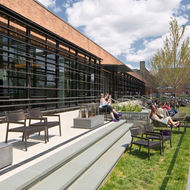04
Student Spaces at the Brody School of Medicine
ROLE: DESIGNER, RESEARCHER
August 2020 - December 2020
Project completed in Cornell University with Abigail Auwaerter, Annabelle Davy, Amina Hasan, Isabel Herczg, Jacky Lin
Instructor: Professor Lorraine E. Maxwell
ABOUT THE PROJECT
Redesign of the student spaces That Supports the medical student's physical, mental, and academic needs
This project provides a programming document for the student spaces that serve the Brody School of Medicine at East Carolina University in Greenville, North Carolina. Programming recommendations will be based on qualitative data collection from the students and staff of the Brody School of Medicine. The students’ spaces are defined as spaces that support students’ social, physical, and emotional needs outside of an academic setting like a classroom or lab. Serving a student body of approximately 469, the space needs to have various setups to accommodate the vast range of student needs.
01
Current Status
SETTINGS & TECHNOLOGY
With the help of cutting-edge technology, the Brody school now uses a more hands-on course system with increased clinical experience to bring learners together. This active learning concept also applies to student spaces. In addition, an environment to support the integration of different kinds of technologies is also needed.
"BRODY FAMILY" COMMUNITY
The Brody School emphasizes the friendly learning community and close relationship between students and professors and coins it as the “Brody Family.” The student lounge fosters a community-friendly space to bring students together.
CONNECTION TO THE UNIVERSITY
Medical school is rather removed from other buildings of health occupation study, which poses a challenge when trying to encourage interdisciplinary interaction amongst students from different fields such as nursing and dental. However, providing a professional learning environment that brings students from other schools to work collaboratively to improve patient outcomes is crucial.
COLLEGE OF NURSING
BRODY SCHOOL OF MEDICINE
SCHOOL OF DENTAL MEDICINE
02
User Personas
These personas are based on the interviews we conducted with the five medical students and three administrators at the Brody School of Medicine.
Naomi
1ST YEAR MEDICAL STUDENT
NEEDS
-
Intuitive wayfinding
-
A place that accommodates individual studying
Naomi is a first-year student looking to connect with other new students and is excited to join the “Brody Family.” As someone who is extraverted, she is looking forward to interacting with students. However, she’s heard from upperclassmen that the first-year course load is rigorous and that she’ll be doing much independent studying. Being new to the school, she has difficulty navigating throughout the building and gets lost frequently.
WANTS
-
A collaborative space to interact with and meet new and current medical students Sense of belonging
-
A welcoming environment

John
2ND YEAR MEDICAL STUDENT
NEEDS
-
Space dedicated to quiet studying
-
A place to store meals
John is a second-year medical student who appreciates studying alone but enjoys taking breaks and spending time with friends. He likes to use the student lounge to eat his meals and decompress from schoolwork. However, he finds it challenging to find a place to study due to first-year students taking up most of the individual study spaces. Since he spends much time in the student space, John would like to personalize his studying area. As someone who enjoys being active, he would appreciate amenities and spaces that allow for outdoor and mild exercise access.
WANTS
-
Personalization of study space and lounge
-
A space to decompress with peers and friends
-
Access to outdoor spaces

Emily
3RD YEAR MEDICAL STUDENT
NEEDS
-
Access to monitors and outlets
-
Rooms that accommodate private meeting spaces for 1-2 people
Emily already had two years of medical school under her belt and preparing for professional practice. As she’s involved in more collaborative courses and projects, she would appreciate spaces that accommodate private meetings that facilitate collaboration through whiteboards and technology. As she doesn’t get many opportunities to go outside, she wishes to access daylight and nature within the building. Emily likes to use the zen room to pray and meditate to decompress, but it's often already used since there’s only one room available.
WANTS
-
Secluded area for praying and meditation
-
More access to daylight and views of nature
-
Rooms that have access to whiteboards

ANDREW
ADMINISTRATOR
NEEDS
-
Spaces that accommodate group discussions (4-6 people)
Better ventilation and acoustic systems in the building
Andrew is an administrative member and is the Assistant Dean for Medical Education Outcomes and Assessment. One of the main concerns is regarding students’ mental health and hopes the student spaces can support their holistic wellbeing. He also wishes to encourage interdisciplinary interaction with all the health sciences students to create a professional network. As Andrew has been with Brody for a long time, he knows the building is out-of-date and needs upgrades to the ventilation and acoustic systems.
WANTS
-
Improve students’ mental and physical health
-
Strengthen the “Brody Family” connection
-
Greater interdisciplinary interaction among all health sciences students

03
Scholarly Research
This section focused on research to understand the current literature on educational spaces and their effect on student health and performance. This literature review will be used in our recommendation stage to help develop and support the goals and performance requirement statements for the student spaces.
04
CASE STUDIES
In this section, our team analyzed several case studies of existing student spaces to understand the critical considerations in developing a space for college students, specifically looking into spaces used by students in the health sciences and medical field.
UNIVERSITY OF CINCINNATI HEALTH SCIENCES BUILDING
UNIVERSITY OF NORTH DAKOTA SCHOOL OF MEDICINE & HEALTH SCIENCES
STUDENT CENTER AT GEORGETOWN UNIVERSITY
UNIVERSITY OF CINCINNATI HEALTH SCIENCES BUILDING








After reviewing the four case studies, our team gathered several insights and identified common characteristics that will help us develop recommendations for the student spaces at the Brody School of Medicine.
.png)
SOCIAL HUB
A common theme across all the sites was to create a place where students could socialize, collaborate, and interact with others to promote interdisciplinary learning and connection. They accomplished this by creating central spaces that act as hubs for social and collaborative activity.

FLEXIBLE & ADAPTABLE SPACES
Furthermore, all the spaces and designs were built to consider future changes that may occur in medical education, technological advancements, the types of activities people engage in, and the number of students that may occupy a space. By designing spaces to be multi-use and flexible for both the near future and in the long-run, it enables these structures to change over time and adjust to the users' needs.

CONNECTION TO NATURE
Lastly, all the case studies incorporated design elements that enabled students to access daylight and nature, whether bringing nature in from the outside or providing entry points to the outdoors. This highlights the importance of providing students with opportunities to engage in nature’s restorative properties and support their holistic wellbeing.
05
CURRENT ISSUES
I. STUDENT LOUNGE
-
Outdated Design: Students and faculty talked about the chairs with writing pads (purple ones in the pictures) are very hard to use and uncomfortable.
-
Adjacency: There is a long walk between lab spaces such as simulation labs and anatomy labs inside the Brody School building and the student lounge where they store clothes.
-
Personalization: The student lounges and study spaces have an unwelcoming atmosphere of furniture, and there are limited opportunities for students to make it their “own” community.
-
Space Configurations: Students report demand for more relaxation spaces to decompress between school & studying, including a more significant number of zen/quiet rooms and phone rooms.
II. COMPUTER ROOM
-
Space Configuration: Through interviews with students and faculty, we learned that many students carry laptops, so the computers are not frequently used.
-
Technology: Both students and faculties report a demand for more printers. They would like to connect their computers to the printers.
III. STUDY SPACE
-
Shortage of Space: Students and administrators report that there is a shortage of study rooms.
-
Technology: Faculties report a need for visual-audio recording and screens for casting presentations in some of the small study rooms. They also noted that whiteboard wallpaper would be helpful.
-
Flexibility: Given the limited building area, it is also important to balance individual and group study spaces and find a way to maximize the use of flexible multi-use spaces.
-
Acoustics: Current individual space is not conducive to quiet study because it has an open setting.

IV. ZEN ROOM
-
Acoustics: Students who take tests in the testing center twice (four times during COVID-19) a week create too much noise when passing by, and students have complained that outside conversations can be heard within the room, disturbing students who are trying to sleep or relax.

V. BUILDING SYSTEMS
-
Natural Light: Due to the structure of the building, many of the student spaces have no access or limited access to natural light.
-
Ventilation: Students need proper ventilation in the changing space where they change clothes after labs.

SHORTAGE OF SPACE

ACOUSTICS

OUTDATED DESIGN

FLEXIBILITY
Allows the product to fit a more diverse situation and more convenient for doctors and patients to use.
Open individual study space is not conducive for quiet study.
No spaces to speak outside of quiet space.
Uncomfortable furniture.
Unwelcoming atmosphere, spaces described as “cinder-block” feeling.
Limited opportunities for students to personalize.
There is an imbalance between individual and group study spaces (flexible multi-use spaces can be broken down for different group sizes).

ADJACENCY

No charging stations are available for students.
Inappropriate location for Zen room.
TECHNOLOGY

Not enough printers in the computer room.
Not enough visual, audio recording devices and screens for casting presentations.
BUILDING SYSTEM
Limited to no access to natural light.
Poor ventilation systems.
06
Future Challenges
In addition to identifying the current issues within the student spaces at the Brody School of Medicine, we have also identified potential future issues that the school may encounter during the design of the new student space.

GROWING CLASS SIZE
With the school wanting to increase the number of students in each class from 87 to 120 students in the future, it is important to consider the size and allocation of space in the new design of the building to ensure that there is adequate space for such growth. Spaces should have the ability to expand and contract depending on the number of students and the types of activities that will occur within a space.

CHANGES IN MEDICAL EDUCATION CURRICULUM
As new changes and developments in the medical field occur, this will ultimately affect how medical education is taught and experienced by students. The new design must be able to prepare and adapt to new and emerging medical technologies and pedagogies so that the students at the Brody School of Medicine are well-prepared to enter the professional medical environment.

ADVANCEMENTS IN TECHNOLOGY
With rapid advancements in technology continuing to occur, the student spaces should have the flexibility and adaptability to implement new technology relevant to medical education and technology that will support the physical and mental well-being of students.

CONNECTION TO OTHER BUILDINGS & FACILITIES
With limited knowledge on the location of the new Brody School of Medicine building and the student space within the building itself, there are issues regarding access, proximity, and adjacency to the hospital, gyms, library, current Health Sciences student center, and other academic or administrative spaces. The new design of the student space will have to take into account the association between the student space and these auxiliary spaces and how to facilitate the connection between them best.
07
DESIGN GOALs & Performance requirement Statements
Adjacency
Acoustics
Technology
Building System
Flexibility
THE BRODY STUDENT SPACES WILL ALLOW FOR QUIET, INDIVIDUAL STUDY SPACES THAT OPTIMIZE PRODUCTIVITY.
-
Individual study spaces should have sufficient acoustic installation (no more than 35 dBa when unoccupied) to reduce noise disturbance [8].
-
Individual study spaces should support the use of technology by providing outlets and opportunities to connect personal devices to monitors and other technological resources.
-
Individual study spaces should provide opportunities for personalization through the use of tackable surfaces, storage space, and whiteboards to create a sense of place and increase intrinsic motivation [9].
-
The study rooms should be equipped with task lighting of 500 lux [22].
-
Individual study spaces should not be adjacent to the testing center to minimize noise disturbance.

Acoustics
Outdated Design
THE BRODY STUDENT LOUNGE WILL PROMOTE SOCIAL INTERACTION AND COMMUNITY ENGAGEMENT TO STRENGTHEN THE “BRODY FAMILY” BOND.
-
The lounge should maximize socialization and community-gathering opportunities through furniture type and placement, room size, and equipment [21].
-
The furniture selection and configuration within the lounge should be comfortable and conducive for social interaction and group work.

-
The lounge should have recreational amenities such as foosball tables, board and video games, and TVs to provide entertainment for students during breaks.
-
There should be a variety of seating styles to support mobility and different types of activities in the space.

-
The lounge should include a kitchenette that is equipped with refrigerators, microwaves, coffee machines, sinks, counter space, and built-in trash receptacles.
-
There should be 2 designated phone booths for students to have private conversations over the phone.
Acoustics
Building System
Outdated Design
Shortage of Space
THE STUDENT SPACES WILL PROVIDE STUDENTS WITH AREAS THAT ARE EXCLUSIVELY FOR RELAXATION AND DECOMPRESSION PURPOSES.
-
There should be 2 zen rooms separated from the student lounges.
-
Zen rooms should accommodate religious practices and provide privacy for worship.
-
Zen rooms should provide opportunities for sleeping with the selected furniture.
-
There should be access to adjustable lighting in the zen rooms so students can control the ambiance for sleeping, praying, meditation, and/or other decompression activities [12].
-
Zen rooms should be constructed with partitions that have a minimum STC rating of 50 to reduce sound transmission from adjacent rooms and spaces [7].



Technology
Building System
Flexibility
Shortage of Space
THE BRODY STUDENT SPACES WILL SUPPORT STUDYING AND COLLABORATIVE WORK WITH SMALL GROUP AND LARGE GROUP MEETING SPACES.
-
The collaborative study space should incorporate a mixture of open and private group workspaces [23].
-
The group workspaces should be equipped with projectors, whiteboards, and other relevant equipment to support brainstorming and group discussion.
-
The furniture in the large group meeting rooms should accommodate 10-15 people.
-
The furniture in the small group meeting rooms should accommodate 4-6 people.
Adjacency
Acoustics
Technology
THE BRODY STUDENT SPACES WILL HAVE A COMPUTER ROOM TO PROVIDE STUDENTS ACCESS TO TECHNOLOGY.
-
The computer rooms should be equipped with 7-10 desktop computers.
-
Access to the computer room should only be available to people with a Brody School of Medicine or ECU student, faculty, or administrative ID.
-
There should be 4-5 printers available for students to use.
-
Charging stations should be available throughout the space to plug-in 20 personal devices such as laptops, tablets, and phones.
-
The location of the computer room should be adjacent to the individual study rooms and the group study space.
-
The computer room should not be directly accessible from the main entrance of the student space.

Technology
Building System

THE BRODY STUDENT SPACES WILL BE EQUIPPED WITH EFFICIENT AND ADVANCED BUILDING SYSTEMS.
-
The student spaces should have access to natural daylight through windows [15] and views of nature [14].
-
The study spaces should provide healthy and comfortable indoor air quality through the ventilation and HVAC system [2].
-
The student spaces should include adaptable technological accommodations for personal devices.
-
All the facilities within the student space should have access to wifi and cell reception.
-
The operative temperature in the student space should range from 68.5F to 75F in the winter, and from 75F to 80.5F in the summer in accordance with ASHRAE thermal comfort guidelines [4].
Acoustics
Building System
Shortage of Space
BRODY SCHOOL STUDENT SPACES WILL BE ACCESSIBLE BY PERSONS OF ALL PHYSICAL & COGNITIVE ABILITIES.
-
The student spaces should have accommodating furniture, facilities, and navigation for persons with disabilities.
-
Spaces should take into account noise and lighting for students with vision and hearing impairments [10].
-
All restrooms and changing rooms should have an ADA accessible bathroom [1].
-
The student spaces should comply with the 2018 North Carolina Building Code.
-
The clear width of a door opening should be a minimum of 32 inches [1].
-
All technology used by the school for academic and student needs should be accessible to individuals with disabilities or otherwise provide equal access to the educational benefits afforded by technology in compliance with Section 504 and Title II [1].

08
Adjacency Diagram
An adjacency diagram is a conceptual sketch that illustrates the proximity and general sizes of spaces. This helps visualize the relationship requirements of spaces and provides designers a clear understanding of important space requirements.

RESTROOMS
Single-occupancy bathrooms that are ADA compliant. Includes some counter space and storage to place personal items for changing.
Computer Room
LOCKER ROOMS
Located adjacent to the student lounge. Separate female and male multi-stall restrooms that include a changing room with lockers
INDIVIDUAL STUDY SPACES
1-person occupancy. Adjacent to but separate from group study spaces and lounge. Must include acoustic and physical elements for privacy. Also should consider students’ desire for the personalization of spaces.
STUDENT LOUNGE
Provides a space to eat meals, socialize with peers, watch TV, and play games. Also includes a kitchenette with microwaves, refrigerators, sinks, coffee machines.
GROUP STUDY SPACES
Rooms are equipped with either a monitor or a big screen/ projector and moveable whiteboard and/or whiteboard wallpaper.
PHONE BOOTHS
Sound-insulated booths that are equipped with a power outlet and small desk, used exclusively for receiving and taking phone calls.
COMPUTER ROOM
Access to desktop computers, printers, and charging ports for personal and portable technology.
ZEN ROOM
A place for individual meditation, prayer, and quiet time. The space is separated by partitions to increase privacy and each partitioned space will take up 75 sq ft.
MULTI-PURPOSE ROOM
Adjacent to the zen room, this space is meant for free expression and also allows for other relaxation and decompression activities such as yoga.
NON-ACADEMIC
ACADEMIC
AMENITIES
PRIMARY ADJACENCY
SECONDARY ADJACENCY
TERTIARY ADJACENCY
ENTRANCE
09
Summary of Actions
-
A main student lounge, zen, multipurpose room, and locker room, separated from the academic and study spaces, be added to the new student spaces into order to provide students with places to decompress.
-
The Brody student lounge include amenities, such as a ping pong table, and provide a variety of seating options that promote social interaction and community engagement to strengthen the “Brody family”.
-
New facilities will be equipped with efficient and advanced building systems. As opposed to other spaces and facilities in the school of medicine, the student lounges are intended to fit the specific needs of students in both an academic and non-academic way. The students will feel a sense of belonging and ownership of the spaces because they will align with their needs. This includes both the spatial and technical needs of the students and the growing medical school class sizes.
10
REFERENCES
[1]
2010 ADA Standards for Accessible Design. Information and Technical Assistance on the Americans with Disabilities Act. (n.d.). Retrieved from https://www.ada.gov/2010ADAstandards_index.htm.
[2]
Allen, J. G., MacNaughton, P., Satish, U., Santanam, S., Vallarino, J., & Spengler, J. D. (2016). Associations of Cognitive Function Scores With Carbon Dioxide, Ventilation, and Volatile Organic Compound Exposures in Office Workers: A Controlled Exposure Study of Green and Conventional Office Environments. Environmental Health Perspectives, 124(6), 805–812. https://doi.org/10.1289/ehp.1510037
[3]
American Society for Testing and Materials. (2003). International Building Code.
[4]
American Society of Heating, Refrigerating and Air-Conditioning Engineers. (2017). ANSI/ASHRAE Standard 55: Thermal Environmental Conditions for Human Occupancy.
[5]
American Society of Heating, Refrigerating and Air-Conditioning Engineers. (2019). ANSI/ASHRAE Standard 62.1: Ventilation for Acceptable Indoor Air Quality.
[6]
American Society of Heating, Refrigerating and Air-Conditioning Engineers. (2019). ANSI/ASHRAE Standard 62.2: Ventilation and Acceptable Indoor Air Quality in Residential Buildings.
[7]
ASTM E413 - 16: Classification for Rating Sound Insulation. American Society for Testing and Materials. (n.d.). Retrieved from http://www.astm.org/Standards/E413.
[8]
Busch, T. A. (2003). ANSI S12.60 (2002) Testing of Modular Buildings Used as Classrooms. The Journal of the Acoustical Society of America, 114(4), 2354–2354. https://doi.org/10.1121/1.4809207
[9]
Cordova, D. I., & Lepper, M. R. (1996). Intrinsic Motivation and the Process of Learning: Beneficial Effects of Contextualization, Personalization, and Choice. Journal of Educational Psychology, 88(4), 715–730. https://doi.org/10.1037/0022-0663.88.4.715
[10]
Cox, P. R., & Dykes, M. K. (2001). Effective Classroom Adaptations for Students With Visual Impairments. TEACHING Exceptional Children, 33(6), 68–74. https://doi.org/10.1177/004005990103300609
[11]
Heating, Ventilation and Air-Conditioning Systems, Part of Indoor Air Quality Design Tools for Schools. United States Environmental Protection Agency. (n.d.). Retrieved from https://www.epa.gov/iaq-schools/heating-ventilation-and-air-conditioning-systems-part-indoor-air-quality-design-tools.
[12]
Inside Innovation Backgrounder Adaptive Relaxation Space. Philips Design & Innovation Communications. (n.d.). Retrieved from https://www.philips.com/consumerfiles/newscenter/main/design/resources/pdf/Inside-Innovation-Backgrounder-Adaptive-Relaxation-Space.pdf.
[13]
Koenig, M., & Johnson, P. S. (2018, April). Relaxation Rooms: How Effect Are They at Reducing Stress Among College Students? Retrieved from https://www.researchgate.net/publication/324687687_Relaxation_Rooms_How_Effective_Are_They_at_Reducing_Stress_Among_College_Students.
[14]
Matsuoka, R. H. (2010). Student Performance and High School Landscapes: Examining the Links. Landscape and Urban Planning, 97(4), 273–282. https://doi.org/10.1016/j.landurbplan.2010.06.011
[15]
Mirrahimi, S., Ibrahim, N. L. N., & Surat, M. (1970, January 1). Effect of Daylighting on Student Health and Performance. Retrieved from https://www.semanticscholar.org/paper/Effect-of-daylighting-on-student-health-and-Mirrahimi-Ibrahim/95c6e9cb569bb6eb810f1a2ceb0972ce85cb6086.
[16]
National Fire Protection Association. (2016). NFPA 70: National Electrical Code.
[17]
National Optical Astronomy Observatory. (n.d.). Recommended Light Levels (Illuminance) for Outdoor and Indoor Venues. Retrieved from https://www.noao.edu/education/QLTkit/ACTIVITY_Documents/Safety/LightLevels_outdoor+indoor.pdf.
[18]
Nordquist, J., & Laing, A. (2015). Designing Spaces for the Networked Learning Landscape. Medical Teacher, 37(4), 337–343. https://doi.org/10.3109/0142159x.2014.1001349
[19]
Oswalt, S. B., Lederer, A. M., Chestnut-Steich, K., Day, C., Halbritter, A., & Ortiz, D. (2018). Trends in College Students’ Mental Health Diagnoses and Utilization of Services, 2009–2015. Journal of American College Health, 68(1), 41–51. https://doi.org/10.1080/07448481.2018.1515748
[20]
Shishegar, N., & Boubekri, M. (2016). Natural light and productivity: Analyzing the impacts of daylighting on students’ and workers’ health and Alertness. International Journal of Advances in Chemical Engineering and Biological Sciences, 3(1). https://doi.org/10.15242/ijacebs.ae0416104
[21]
Sıramkaya, S. B., & Aydın, D. (2014). “Social Space” Concept in the Psycho – Social Development of University Youth and Its Exemplification in Faculty Buildings*. Procedia - Social and Behavioral Sciences, 140, 246–254. https://doi.org/10.1016/j.sbspro.2014.04.416
[22]
United States General Services Administration. (2017, August 13). GSA 6.15: lighting. Retrieved from https://www.gsa.gov/node/82715.
[23]
Wiwel, C., Swenson, J., Su, M., Blackburn, M., Johnson, A., & Finelli, C. (n.d.). Out-Of-Class Impacts of Flexible Classroom Spaces. 2019 ASEE Annual Conference & Exposition Proceedings. https://doi.org/10.18260/1-2--33149































